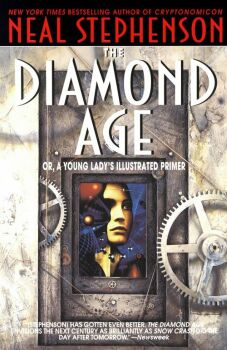
Writing about the future has to be a considerably difficult endeavor. There are some science fiction writers who approach the future as pure fantasy. It doesn't matter how we got there, we're there now, so let's get on with the story. Other writers, and this is one of the characteristics that seems to differentiate cyberpunk from other sci-fi sub-genres, maintain a very clear time line from the present. Neal Stephenson is definitely in the latter category. In The Diamond Age; or, A Young Lady's Illustrated Primer, Stephenson describes a twenty-first (or possibly twenty-second) century Earth that has seen the development of cultural identities that simultaneously ignore and rely on territorial boundaries. This is intriguing when you stop to consider how the Internet has allowed people with common interests to communicate across the globe. Stephenson adroitly extends the concept onto a larger, more advanced populace. The setting also builds on the franchising-run-amok scenario that set the stage for his 1992 novel Snow Crash, but with more dignity. This dignity presumably arose out of the relative chaos of Snow Crash's world, which is even alluded explicitly at one point, and out of the advent of nanotechnology, which forms the basis of much of the story in The Diamond Age.
That story has to do with a book designed by a Neo-Victorian engineer living in China, a book designed in an age when traditional books are obsolete. This, however, is no traditional book. It is an interactive, adaptive book, developed for a Victorian Equity Lord in order to teach his granddaughter in a manner that had all but disappeared from the modern curriculum. Through what appear to be several twists of fate, a copy of the book winds up in the hands of a poor, neglected young girl named Nell. As Nell learns from the Primer, she embarks on a journey from her squalor into the heart of a conflict that is set to consume all of China. This conflict also draws the creator of the Primer, and a young woman who has been interacting with Nell through the book, into a tangled web of technology and people that does not unravel entirely until the very end of the novel.
The most striking thing about this book is the language. After the crash-and-burn pace of Snow Crash, I wasn't prepared for The Diamond Age to be so damned poetic. Stephenson's imagery is priceless, particularly in an early scene where John Percival Hackworth, the designer of the Primer, witnesses some more primitive means of technology in the laboratory of a shady character who he has approached in order to create a copy of the Primer for his daughter. As he did with Sumerian mythology in Snow Crash, Stephenson immerses the reader in Chinese, and particularly Confucian, culture. His characters, with a few possible exceptions, are deep and intriguing, and the dialog is peppered with philosophical insights that add even more to an already dense story. As a whole, this is a great read, and an intriguing possiblity for the world as we will know it one hundred years from now.
in this section:
search
recent entries in REVIEWS
August 14, 2008
Lollapalooza 2008 Day 2 (8/2/2008)
August 14, 2008
Lollapalooza 2008 Day 1 (8/1/2008)
August 14, 2008
Lollapalooza Day 3 (8/5/2007)
August 14, 2007
Lollapalooza Day 2 (8/4/2007)
August 7, 2007
archives by month
3 posts
August 2007
3 posts
September 2005
1 posts
August 2005
1 posts
February 2005
1 posts
February 2004
2 posts
COMPLETE MONTHLY ARCHIVES